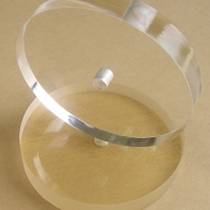Joining Acrylic Plastic Sheets
Solvent cement is recommended for joining acrylic. There are two techniques for solvent cementing, capillary and dip or soak methods.
Capillary cementing
 This is the most popular acrylic joining method. However, this method will not work at all unless the parts to be joined fit together PERFECTLY.
This is the most popular acrylic joining method. However, this method will not work at all unless the parts to be joined fit together PERFECTLY.
Make sure the parts fit properly. Then join them with masking tape or clamp them in a form to hold them firmly in place. It is important that the joint be in a horizontal plane, or the cement will run out of the joint.
Apply the cement carefully along the entire joint. Apply from the inside of a box-corner joint, and on both sides of a flat joint. A needle-nosed applicator bottle is recommended. The thin cement will flow into the joint through capillary action and form a strong bond. Maximum bond strength will not be reached for 24 to 48 hours.
Soak or dip cementing
This is suggested only for THICK joints.
Viscous cementing
Viscous cements are used for joints that can’t be cemented with capillary or soak cementing, either because the joint is difficult to reach or because the parts don’t fit properly. Viscous cement is thick and will fill small gaps. It can make strong transparent joints where solvent can’t.
You can make your own viscous cement by dissolving chips of clear acrylic sheet in a small amount of solvent.
Apply a small bead of cement to one side of the joint, join the pieces, and tape or clamp in place until cured.

